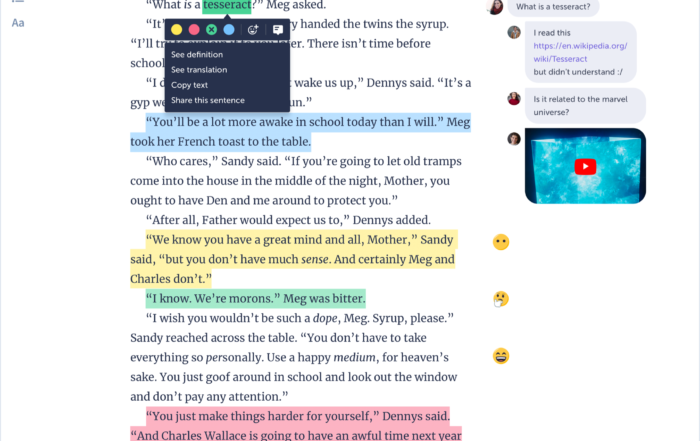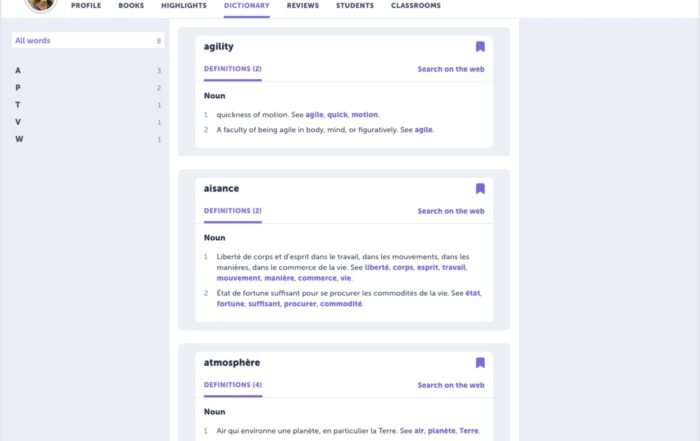Building Student Vocabulary Lists
Samantha Reichard/ September 8, 2020/ Classroom Tips, ELA/ 0 comments
Tips for Building Vocabulary Lists That Are on Point
Learning new words and making meaning is a cornerstone of ELA education. In an attempt to build up student schema and language mastery, we’ve often relied on class-wide vocabulary lists and word walls, which are usually rotated in and out depending on the communal literature being read, to create learning experiences for our students.
Oftentimes we overlook the purpose behind vocabulary exercises and instead rely on replications of our own learning experiences to inform how we set up our students to understand and decode grade-level texts. Unfortunately, by pushing uniformity within student language acquisition in the classroom, we are not only stagnant in our own teaching practice, but also hold back our life-long learners.
Student Agency and Advocacy in Building Vocabulary
As we lean into the complexities of self-driven learning and doing, we need to think through ways students best leverage agency over their learning. The Victoria State Government defines student agency as “the level of autonomy and power that a student experiences in the learning environment”. As students begin to exercise agency, we can look at all of the ways students can take ownership of their learning practices.
Dr. Tanji Reed Marshall from the Education Trust looked deeper at the impact remote settings are having on student agency in her article “When kids return to school, they may have more agency. Are we ready?”. She explained that “having agency influenced how many students viewed their distance-learning experience and how they organized their time; many found it enjoyable and freeing.” We should capitalize on current momentum to rethink facilitation of standard-based instruction.
It is clear that students need learning tailored to their needs, with their voice being the one to make learning decisions. Looking through the vocabulary lens, this means placing students at the helm. Students should choose which words they want to work toward learning and ways in which they best learn them. While having a class-wide vocabulary list is beneficial for teachers to expose students to words that may be coming up, or are fundamental for student comprehension of a task, it is more powerful for students to take the wheel and build up their own vocabulary in their own way.
This is a complex strategy in reaching students with differentiated approaches. To support your thinking, look below for some ways to build up student advocacy and agency in creation of personalized vocabulary lists.
Set Expectations
The first step in establishing any new procedure is to become clear on what you want students to do, how you want them to do it, and how they will be provided feedback. To begin, write out your vision of excellence. Read through your vision and list out the steps students must follow in order to reach your version of mastery Take a look at the example list of steps below:
- Any time you come across a word that you don’t know how to read, pronounce, or know what it means, you highlight the word.
- After highlighting the word, you use the Glose definition tool to look up the meaning of the word
- In your vocabulary list spreadsheet, add the word and the definition to your list under the “Learning” column
- You must have at least 10 words a week on your list
- When you master a word’s spelling and definition, move the word to your “Learned” column and add a new word onto your “Learning” column
Within this example, it provides a framework on what students are to do to build their own list and how students are to begin to uncover meaning for those words. Get really clear on what you want students to do and how you want them to do it. Once you’ve solidified your expectations, you are ready to begin teaching the exemplar process to your learners!

Teach The Exemplar
Now it is time to translate your bar of excellence into students’ understanding. Start by teaching your students the purpose behind self-driven vocabulary lists. Once students know why they are given accountable agency, they will be more likely to follow through with expectations and be willing to grow through accountable feedback.
There is no better way to model those expectations than by showcasing how you as a teacher are also going to rely on this strategy to build up your own vocabulary. Create your own set of words that you come across in your reading and walk students through how you are adding, defining, and then retiring words within your list. Also, as you continue to grow and refine your list, you are able to problem solve any misconceptions before they are brought up in student practice. When students see you practicing this strategy, you build student buy-in and trust, which can be leveraged to expand their vocabulary!
Set Accountability Measures
Accountability measures are paramount to the long-term success of this strategy. Embed time within your schedule to review every single students’ progress with their words. Provide small, actionable pieces of feedback on what they are doing well and the next step toward mastery. Students will continue to grow and embrace their learning as long as you are showing them that you are consistently monitoring and celebrating them for their successes.Teacher review and input is a top priority, but if we are really embracing the idea of student agency and advocacy, then we need to build up opportunities for students self and peer monitoring and assessment. Have students schedule time within their schedule to look through their lists, match up what they are doing with the class-wide set of expectations, and self reflect on what they are doing well and what they want to continue working on. This also works really well by pairing students together and having them provide feedback on each others’ work.

Put Into (Real World) Practice
We looked at ways to begin building up lists, but we know that building lists doesn’t build up learning. Now we have to look at how we want students to interact with their words to really learn them (beyond memorization). To do so, make learning real by providing time within the lesson for students to purposefully and authentically utilize and practice writing, reading, and speaking their words in the correct context.
Challenge students to use at least four of their words within their speech every day. During writing assignments, set parameters that at least two other words have to not only be used correctly, but to follow up the use with a sentence that provides further contextualization to the meaning of the word. Another way is to have students log onto their feed when they’ve seen or heard their word in a separate setting and how the word was being used. By having students learn through their world context, making meaning just makes more sense.
While learners work through a common class-wide set of expectations, it is a powerful learning experience for students to define what it is that they are wanting to learn. As teachers, we have a responsibility to meet students at their level and to push on their growth as individuals. Real-world focused and student driven practice shows your learners how they can continue to learn new words as they move beyond your classroom. You will be impressed watching your students meet your bar of excellence as they curate their own set of words, work on learning them, then reevaluate and replace with even more words!

About the Author
Samantha Reichard serves as Lead Real Time Teacher Coach for Center City 1 Learning Community in Charlotte, NC, serving as a mission-critical resource for 29 inner-city and Title I schools in the Charlotte Mecklenburg School District. After graduating from the State University of New York at Fredonia, Samantha began her teaching career at East Union Middle School in Union County, NC as an eighth-grade English language arts teacher. After two years, she moved to Charlotte, NC and served as a sixth- and seventh-grade language arts teacher for five years before becoming a multi-classroom leader and real-time teacher coach. Following that, she worked on expanding the model of Multi-Classroom Leader and Real-Time Teacher Coaching (RTTC) for four years at Ranson IB Middle School.
